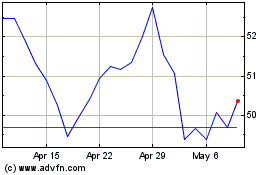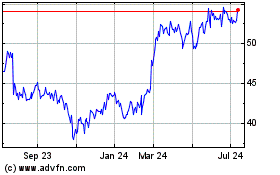By Eric Uhlfelder
With most Treasurys yielding under 2% and savings accounts
yielding even less, individual investors are hard-pressed to figure
out what to do with money they don't want exposed to material
market risk.
One viable alternative is bonds that trade on stock exchanges,
known as exchange-traded bonds.
About $19 billion of these securities trade mostly on the New
York Stock Exchange, with many investment-grade offerings generally
yielding between 5% and 6%.
While tiny compared with the traditional $9.3 trillion
corporate-bond market, exchange-traded bonds generally offer more
transparency than traditional debt offerings. That's because
investors who buy them have the same ease of access to bid and ask
information, current yield and limit orders they enjoy when buying
and selling stocks, says Kevin Conery, fixed-income trading desk
analyst at Piper Jaffrey.
Exchange-traded bonds also have other features that individual
investors might find attractive.
These securities are issued in $25 bonds, compared with $1,000
for traditional corporate bonds. They pay interest on a quarterly
basis versus corporate issues that pay semiannually. And because
issuers can typically call exchange-traded bonds five years after
their initial offering at par and any point thereafter, the yields
are often higher than traditional corporate bonds issued by the
same company.
Companies are willing to offer higher yields on exchange-traded
bonds because the five-year call features gives them more
flexibility to refinance debt if rates fall or eliminate it
altogether if the money is no longer needed -- something that
$1,000 corporates can only do closer to maturity, if at all.
That five-year call feature also can reduce the overall
volatility of these bonds (as long as they aren't suffering from
credit issues), especially after the call date has passed. The
reason: Prices tend to trade close to par within a year or two of
the call and anytime thereafter.
Consider the long-term senior bond of internet-auction giant
eBay Inc., which is listed on the NYSE under the symbol EBAYL. This
investment-grade offering currently yields 5.59% and is trading at
$27.
By comparison, a traditional 4% coupon bond from eBay that
matures in 2042 trades at 99.54 (or $995.40 per bond) and yields
4.14%. And while individuals can make any size purchase of
exchange-traded bonds, there is a minimum online bid of 10
corporate bonds, or $9,954.
With many online major brokerages having eliminated trading
fees, exchange-traded bonds can be bought and sold without cost.
However, because these bonds are thinly traded, investors need to
use limit orders to ensure efficient pricing.
Some caveats
Barry McAlinden, a fixed-income strategist at UBS Global Wealth
Management, cautions investors not to mistake the ease of buying
exchange-traded bonds with reduced need for due diligence.
"While their returns and ostensible safety can be enticing,"
says Mr. McAlinden, "there are many variables that need to be
considered before investing and special caveats that may come into
play during difficult times."
Among the things investors need to consider:
Bond interest is taxed as ordinary income. For higher-income
households, this is going to be a much higher rate than the
up-to-20% rate at which qualified dividends from common and
preferred stock dividends are taxed. As such, tax-deferred
retirement accounts might be an ideal place to hold these
bonds.
Some of these securities are junior subordinated debt, meaning
they have a lower-priority claim against assets if a company goes
into bankruptcy. While senior bonds can't miss payments without
triggering a default, junior subordinated debt can typically defer
interest payments for up to 10 years without doing so. That said,
such deferrals are rare. As UBS's Mr. McAlinden explains, "Such a
deferral would wreck any firms' plans to access capital markets
going forward."
If investors are hoping to benefit from the bond rally -- due to
additional interest-rate cuts -- they shouldn't count on it. Piper
Jaffrey's Mr. Conery explains such a price rise is only likely if
there is at least 3.5 years before the bond is callable. "Prices of
bonds with shorter call dates will likely trade closer to their
call price," says Mr. Conery, regardless of minor changes in
interest rates.
Maturity rates
Still, the hunt for yield is leading some investors to take on
principal risk.
The municipal-bond insurer Assured Guaranty Municipal Holdings
(AGO-B) A-rated 6.875% ultralong-term exchange-traded bond is
trading at $27.50 and can be called anytime with 20 days' notice.
While the current yield of 6.36% looks enticing, a call at this
price would result in a 10% capital loss. To break even, new
investors would need the bond to remain outstanding for at least a
year and a half.
Because the aforementioned eBay bond trades well above par, its
effective annualized yield would be reduced to 1.81% if the company
calls the security a year from now -- its initial call date. (See
table.) Effective yield will rise the longer the bond remains
outstanding as investors receive more quarterly payments.
Maturity dates also are important, especially if that date
stretches into the next century. The longer the maturity date, the
more volatile pricing can be, especially when interest rates move.
Pricing is based on yield and credit spreads over equivalently
termed Treasurys.
Not all exchange-traded bonds are rated. That could mean the
company is confident that its issue will be well subscribed to
without a rating, but it also could indicate a company that doesn't
want to pay for a mediocre grade.
Quantumonline.com maintains a free database to help investors
get started understanding the exchange-traded bond market.
Mr. Uhlfelder writes about global capital markets from New York.
He can be reached at reports@wsj.com.
(END) Dow Jones Newswires
January 05, 2020 22:17 ET (03:17 GMT)
Copyright (c) 2020 Dow Jones & Company, Inc.
eBay (NASDAQ:EBAY)
Historical Stock Chart
From Mar 2024 to Apr 2024

eBay (NASDAQ:EBAY)
Historical Stock Chart
From Apr 2023 to Apr 2024
